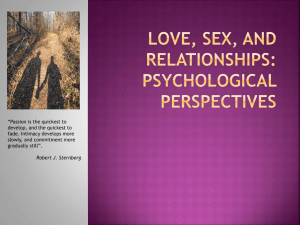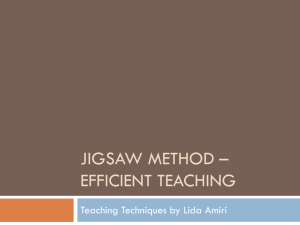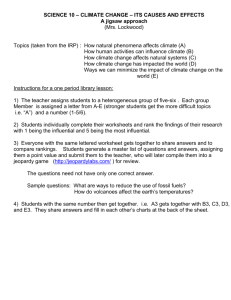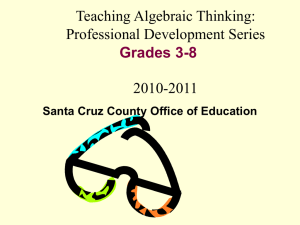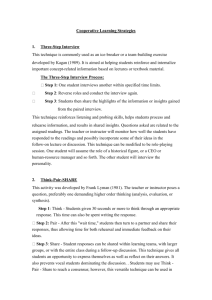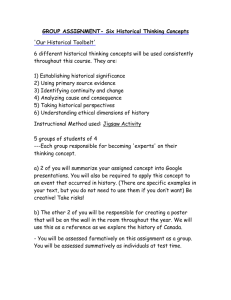TEAM PRESENTATION OUTLINE (Jigsaw)
advertisement
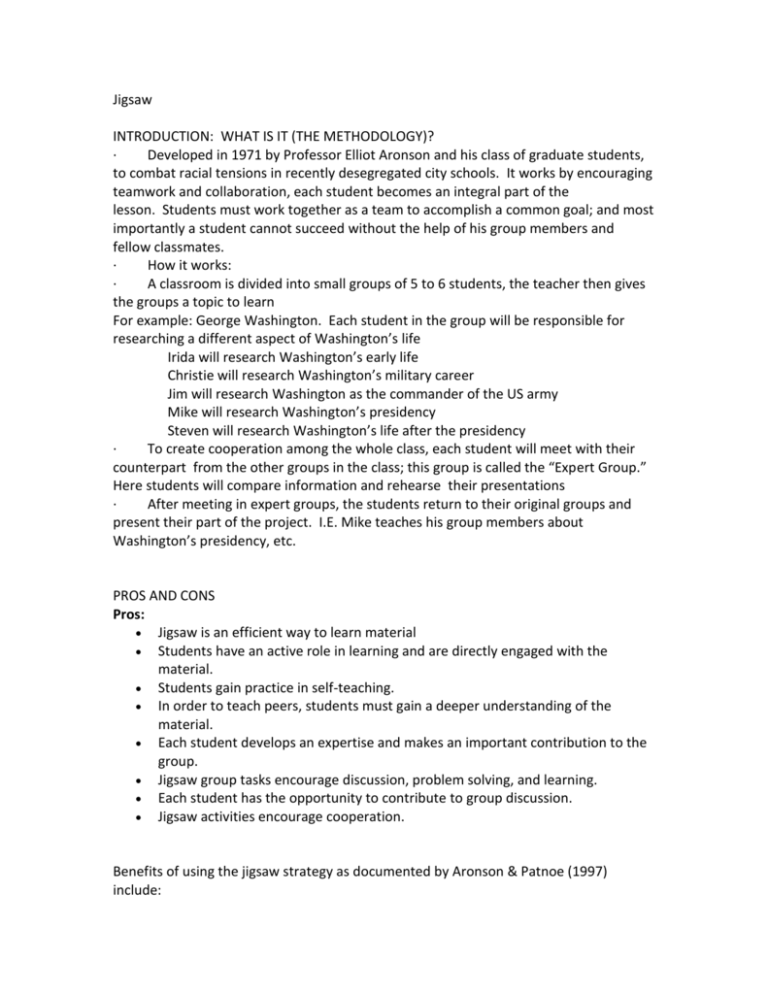
Jigsaw INTRODUCTION: WHAT IS IT (THE METHODOLOGY)? · Developed in 1971 by Professor Elliot Aronson and his class of graduate students, to combat racial tensions in recently desegregated city schools. It works by encouraging teamwork and collaboration, each student becomes an integral part of the lesson. Students must work together as a team to accomplish a common goal; and most importantly a student cannot succeed without the help of his group members and fellow classmates. · How it works: · A classroom is divided into small groups of 5 to 6 students, the teacher then gives the groups a topic to learn For example: George Washington. Each student in the group will be responsible for researching a different aspect of Washington’s life Irida will research Washington’s early life Christie will research Washington’s military career Jim will research Washington as the commander of the US army Mike will research Washington’s presidency Steven will research Washington’s life after the presidency · To create cooperation among the whole class, each student will meet with their counterpart from the other groups in the class; this group is called the “Expert Group.” Here students will compare information and rehearse their presentations · After meeting in expert groups, the students return to their original groups and present their part of the project. I.E. Mike teaches his group members about Washington’s presidency, etc. PROS AND CONS Pros: Jigsaw is an efficient way to learn material Students have an active role in learning and are directly engaged with the material. Students gain practice in self-teaching. In order to teach peers, students must gain a deeper understanding of the material. Each student develops an expertise and makes an important contribution to the group. Jigsaw group tasks encourage discussion, problem solving, and learning. Each student has the opportunity to contribute to group discussion. Jigsaw activities encourage cooperation. Benefits of using the jigsaw strategy as documented by Aronson & Patnoe (1997) include: · · · · · Improved attitudes toward school (when surveyed). Increased self-esteem (when surveyed). Improved academic achievement. Improved perception of support from peers for academic efforts. Lower absenteeism. Cons: Jigsaw does not work well for a topic in which students are expected to know all components equally well. Students accustomed to competing may take some time to adjust to this technique. Lower-achieving students may fail to adequately convey the information to the home group. In expert groups, certain students may try to dominate. Without a group task which incorporates all of the material, there is little incentive to learn from peer teachers. To prevent students from coasting in jigsaw assignments, assign individual work that incorporates all aspects of the jigsaw topic. USES: o Jigsaw is used as a group project that will allow students to teamwork in order to comprehend a concept, task, etc. o Example: Students can be broken up into groups and each group will be given a different type of rock to examine. o In literature students can be assigned different articles, or sections of an article to read. § When students have completed the reading and comprehension of the article(s), there are several ways in which students can display what they have learned about a concept. · Debates and Role Playing are two examples § Example: Groups of students are each given a short story and each group is given a different character in the story to analyze. · i.e. Protagonist, Antagonist, etc SUMMARY -After the Jigsaw Lesson, we will perhaps conclude it with a quiz to show that though it is in game form, it is still a learning activity. Also, we will then describe again to the class what our topic is and review what they have just taken part in and how they can utilize it again for their own future classrooms. WORKS CITED o http://www.jigsaw.org/tips.htm o http://serc.carleton.edu/NAGTWorkshops/coursedesign/tutorial/jigsaw.html o http://serc.carleton.edu/NAGTWorkshops/coursedesign/tutorial/strategies.html#con ceptsketch o http://serc.carleton.edu/sp/library/jigsaws/why.html o http://teachpsych.org/ebooks/pse2011/vol1/39.%20Jigsaw.pdf EXAMPLE OF A JIGSAW ACTIVITY: To start off, the students will be divided into 5- or 6-person jigsaw groups. The groups should be diverse in terms of gender, ethnicity, race, and ability One student from each group will then be appointed as the leader. Depending on the topic of the lesson, it will be divided into 5-6 segments. Each student will then be assigned to learn a segment of the main topic. After giving the students time to research the segments, then time will also be allotted for rereading and comprehending what they have just researched. This will allow them to become more familiar with the topic. Once the individual groups have researched their parts of the main topic, one student from each group (with the same individual topic) will come together to meet and collaborate on what they have researched. These temporary “expert groups” will discuss the main points of their segment and rehearse the presentations they will make to their Jigsaw group. I will then bring the students back to their initial Jigsaw groups. Ask each student to present her or his segment to the group, as well as encourage others in the group to ask questions for clarification. During this time, I will be floating from group to group in order to make sure that the groups are cooperating or facilitating their topics in a productive manner. After they have gained more expert knowledge and become even more proficient on their topics, I will then maybe give a quiz or little questionnaire in order to see that they have indeed gained knowledge, as well as show them that though it is fun and games, it is still learning. In the background, it would be nice to incorporate music that pertains to the topic at hand, in order to influence more critical thinking and creative flow. Ex. Listening to Jazz, when researching the influence of music in America in the early 20’s. Also, Students in their groups may utilize poster boards, booklets, or even technology such as PowerPoint to put together their segments. This will allow them to not only present their topics in a more fluid manner, but also keep track of and be able to have them for later use. FURTHER READING · http://teachpsych.org/ebooks/pse2011/vol1/39.%20Jigsaw.pdf (Journal Article) FAIRY TALE FUN -- JIGSAW STYLE! When Berg wanted her students to grasp the concept of the definition of a fairy tale, she decided that it was the perfect opportunity to incorporate the jigsaw approach. Berg began by having her students divide into five equal groups. Each group got one fairy tale to read. The stories were "The Ugly Duckling," "Snow White," "Hansel and Gretel," "Jack and the Beanstalk," and "The Three Little Pigs." Each group was responsible for collecting the following information: Who are the characters in the story? Where does the story take place? What are the major events of the story? Are there any magical or supernatural events? If so, what are they? After the students read, discussed, and recorded the above information, Berg split them into jigsaw groups. One person from each fairy tale assembled in a new group. (She assigns the jigsaw groups because it is difficult for her students to create these new, blended groups quickly.) In their new groups, students were each given three minutes to tell the other group members about the story they had read as well as the information they had collected. After that, the group had to create a poster and give a presentation that addressed two points: 1. What do all five stories have in common? 2. Using what you found in common, write your own definition for a fairy tale. "They started out trying to find simple commonalities like characters, but that did not work," said Berg. "They had to dig deeper to get any real commonalities. For example, some of them pointed out that men were usually the heroes, that there was usually a battle or conflict between good and evil, and that the good guys always won. They touched on ideas that the stories were timeless and could have happened at any time in history. They also said the stories tried to teach a lesson about how you should act -- a moral lesson." Not until after the presentations did Berg discuss the definition of a fairy tale according to the literature textbook. The students were excited to see that they really had developed a very accurate description of the concept, and they were more open to Berg's mini lesson that followed. "Other activities I connected to this unit included a compare-contrast essay comparing 'The Three Little Pigs' and The True Story of the 3 Little Pigs [by Jon Scieszka] told from the wolf's point of view," Berg stated. "I also did another jigsaw activity for the final leg of the unit in which students read and compared five different versions of 'Cinderella' and then defined what a 'Cinderella story' was using the commonalities among the stories. Some groups chose to present their information in play form, and they were fantastic!" http://www.comedyimprov.com/music/schmoll/tales.html
